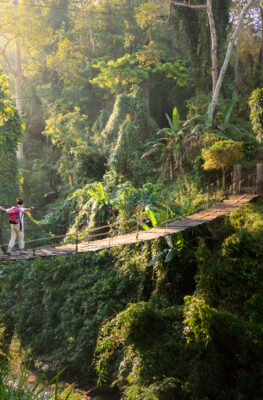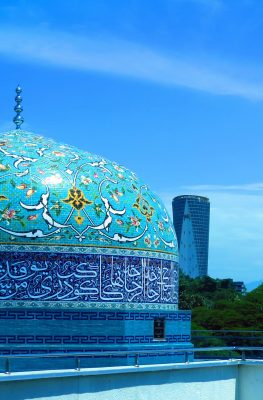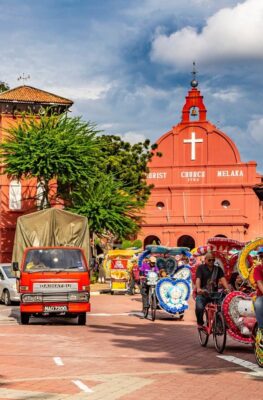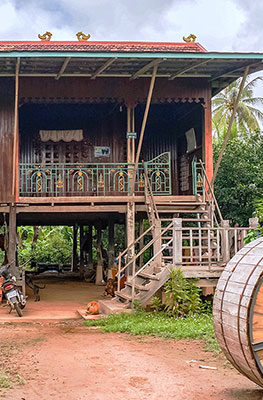Published on June 8, 2018
Sarawak Cultural Village, Malaysia. Image courtesy of Tourism Malaysia.
It’s getting more and more difficult to find authentic culture in Southeast Asia – swamped as it is with counterfeits and cheap knockoffs – but you can find it easily if you know where to go.
The places we’ve listed here may be a little out of the way, but travelers who visit these places will be rewarded with indelible experiences of local cultures, with souvenir remembrances if you’ve got some spending change!
Sarawak Cultural Village, Malaysia: Living Tribes
Touted as a “living museum”, the Sarawak Cultural Village encapsulates Sarawak’s cultural diversity, showcasing the lifestyle of the state’s many ethnic groups.
Walk around and you’ll meet some of the 150 people living in the village, wearing traditional attire and giving you hands-on demonstrations from different Sarawak tribes.
Even the buildings represent Sarawak’s traditional communities, from the tallhouses of the Melanau to the longhouses of the Iban and Bidayuh. The Iban longhouse has a capacious communal hall often used for cultural demonstrations like basket-weaving and wood carving.
The twice-daily elaborate cultural performances take place in the village theatre, which is also the venue for the annual Rainforest World Music Festival.
The Traditional Village is located in Pantai Damai, Santubong, some 32 km from Sarawak’s state capital, Kuching.You can visit their official page here: www.scv.com.my.
Lake Sebu, Philippines: Weavers of Dreams
The T’Boli tribespeople of the Philippines’ 380-hectare Lake Sebu draw inspiration from their dreams to weave patterns in their traditional t’nalak cloth. You can watch Lake Sebu’s “dreamweavers” at work when you visit Lake Sebu, along with other examples of T’Boli craft, like their hegalong music and brasswork.
The weaving shop of Philippines National Artist Lang Dulay in Poblacion is probably the best place to see these artists at work, weaving naturally-dyed abaca hemp into their dream-inspired designs.
Lake Sebu’s peaceful setting may be the key to the T’Boli’s creativity. Jona Branzuela Bering of Backpacking with a Book found this firsthand: “My days in Lake Sebu were as calm as quiet as the massive lake I saw from the resort balcony,” she tells us. “Egrets perching on the tree took flight before the morning rays touched the lake’s skin [as] the fishermen’s canoes knifed through the lake to check their tilapia farms.”
When visiting, hire a T’boli tour guide to accompany your trip with running commentary, and make sure to see the local T’Boli perform indigenous dances, songs and musical instruments.
Luang Prabang, Laos: Faded Royalty
Known as “the best preserved city in Asia”, Luang Prabang simply wows the visitor with French colonial villas, traditional tribal houses, and magnificent gilded temples, all in a picturesque riverside location.
This former royal capital possesses a wealth of history and a rich blend of Indochinese European culture, all of which won it recognition as a UNESCO World Heritage Site. Succeeding Asian and European colonial influences are evident in Luang Prabang’s French colonial houses around town, and the former Royal Palace that now serves as Laos’ national museum.
Key sights in the National Museum include the mirrored Throne Hall, immaculately-preserved royal living quarters, and pavilions showing the Last King’s car collection and the Prabang Buddha that gave the city its name.
Finally, Luang Prabang’s 30-plus Buddhist temples are worth a day of exploring. Arguably the most important one, Wat Xieng Thong, is a beautiful example of Buddhist architecture built to be worthy of the royal ceremonies it once hosted.
Kampong Glam, Singapore. Image courtesy of Mike Aquino
Kampong Glam, Singapore: Trading Throwback
The Islamic DNA of Singapore’s Kampong Glam can be instantly guessed from the Sultan Mosque and its massive gold dome at the very center of the neighborhood. The area’s distinct Arab influence shows off a cultural ferment that feels very different from that going on in the rest of hypermodern Singapore, one that seems more authentically plugged into the past.
The rows upon rows of shophouses radiating away from the Sultan Mosque show what shopping must have been like a century ago – perfumes, carpets and other traditional wares sold in a friendly manner by owners who personally tell you the history and value of their goods. Not a few are still managed by descendants of the Arab merchants who once made Kampong Glam the “little Arabia” of the last century.
The massive, gold-domed Sultan Mosque itself serves as the focal area for the neighborhood’s trade and culture. The mosque is crammed to the brim with worshipers for Friday prayers; on special holidays like Ramadan and Eid’l Adha, the pedestrianized Bussorah Street extending southeast from the mosque transforms into a street shopping arcade filled with stalls hawking dates, cakes, candy, and other Malay and Arab specialties.
Arts & Handicraft Centre, Brunei: Big-Ticket Culture
Tiny Brunei has an unexpectedly rich tradition in fabrics and weapons-making, all of which can be explored in depth at the Brunei Arts and Handicrafts Training Centre along the Brunei River east of Sungai Kianggeh.
Classes for Bruneian youth keep traditional crafts alive, from silversmithing to woodworking to songkok-making. You can visit the Centre to admire their handiwork: traditionally-crafted regalia like ornamental brass cannons, ceremonial keris (swords) and silverwork, made the same way as their ancestors did.
Even better, you can buy one of the Centre’s products, though prices are on the high end (about USD 300 for a ceremonial sword or brass cannon, cheaper for fabric handiwork). For last-minute shoppers, you can also buy their products at their outlet at the Airport Departure Lounge.






